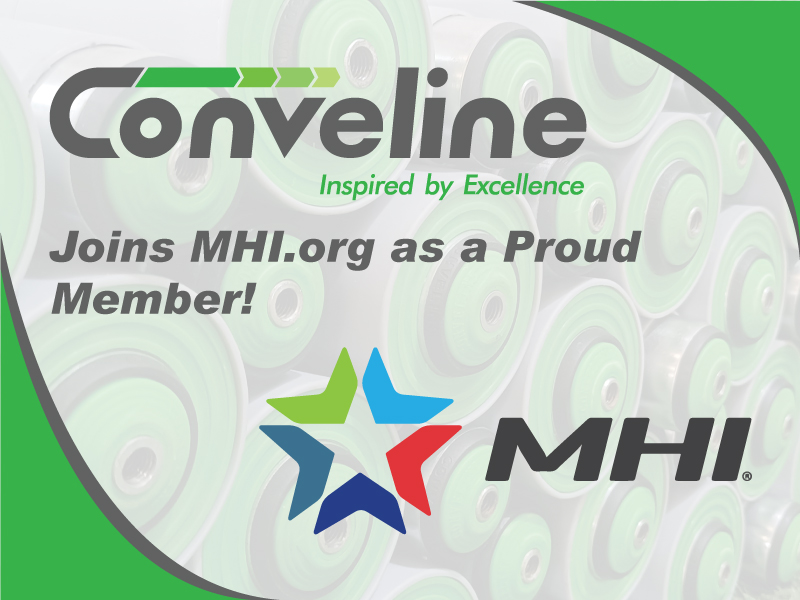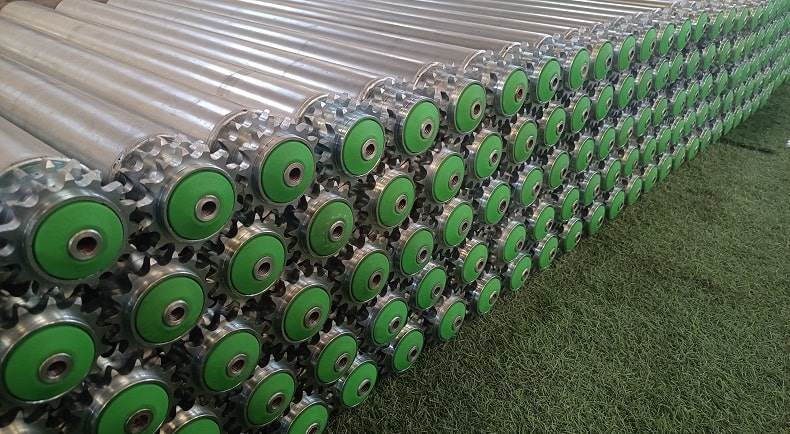
- Conveline Systems
- 19th Mar 2022
- Conveline Rollers
The term roller conveyor literally refers to a series of rollers contained within a frame, designed to the required length, width and height and avoids the need for personnel to manually pick up heavy loads or lighter loads continuously over a shift, avoiding the risk of any sort of injury.
POWERED ROLLER
Powered Rollers are more suited than Gravity Roller where longer distances and/or controlled speeds are required to transport packages without the need for human assistance with potentially big labour savings.
Powered Roller come in several forms depending upon the application, products, and the philosophy of the whole conveyor system. Lineshaft Powered Roller Conveyor is one such system, which as its title suggests, is powered via bands from a drive shaft beneath the rollers and is suitable for both slower throughput volumes and conveyor systems which change direction resulting in a number of bends in the layout.
Under belt driven powered roller conveyors are more suited to higher speeds, heavier weights, and long straight distances. Also, they have fewer moving parts so lower maintenance costs and quieter running. These can also be utilised when product accumulation is required in buffer situations.
24V driven powered roller are ideal for creating zones where different sizes and shapes of products can be accumulated without them touching. They rely simply on one 24-volt motorised roller with round or “V” belts connecting several adjacent non-driven rollers to create zones which can be independently stopped/ started and only run/index as required so low running cost. Also, they have very few moving parts so lower maintenance costs and quiet running.
• Powered Rollers speed up processes in production and warehouse environments.
• They can be easily controlled and the risk for damage from human error is greatly reduced.
• Powered Roller Conveyors reduce the number of personnel needed for moving products.
• They can increase factory/warehouse movement of personnel/materials as they can be designed with other types of powered conveyors to elevate and convey products overhead.
• With the aid of bar code or similar scanners, powered roller conveyor can be easily adapted to sort products into destination lanes.
• Powered Rollers reduce the risk of personnel injuries from manual handling
• They can be programmed to route different products to various processes and automatically interface with associated equipment.
GRAVITY ROLLER
Gravity Roller are the most economical and common method of conveying unit loads and are a simple low capital cost and ergonomic way to move products around either by pushing along by hand on a level section, or with the aid of a decline, products roll under gravity. They move product loads without the need for a drive motor to provide the motive power.
Gravity Roller are typically mounted on a slight decline angle, therefore using gravity to assist product movement, especially for longer distances. They can also be used in applications where the conveyor is level and operators can push the product along to its final destination or pushing along via multiple workstations, if needed.
• They need negligible maintenance cost as there is very little that can go wrong.
• Gravity Rollers can be easily re-configured and cheaply replaced in the event of accidental damage.
• They are very versatile as they come in a wider variety of conveyor roller diameters and materials than is available for a powered conveyor.
• Gravity Rollers need no power requirements so environmentally friendly and quiet running.
Recent Posts

Conveline Joins MHI.org as a Proud Member!
March 13, 2024

Advantages of Using Conveline’s Powered Rollers - 24V DC Roller Motors in Conveyor Systems
September 02, 2022

What should be the ideal Load Carrying Capacity of Conveyor Rollers?
April 07, 2022

How to Select a Gravity Roller Conveyor
March 31, 2022

Steel v/s Plastic Conveyor Rollers
March 24, 2022
